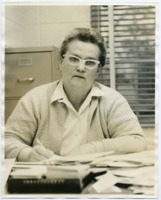
Browse Items (55 total)
Sort by:
-
Letter Regarding the Case and Barbora Hazle's Statements.
This letter, written on May 12, 1856, has several names that are illegible, including the author's. It is addressed to two men, the first being [Daniel] P. Pool, and is a lengthy letter in response to a letter received from Abner C. Wellborn and in particular, the supporting testimony of Barbara Hazel accusing Abner Tate of at least two murders. The author states that the credibility of Hazel's words should be questioned due to the several reasons he goes on to detail. Following the original letter, the author pens an amendment to include changes that occured since the original letter was written as Tate had made a recent publication during that time. -
Statement Letter of D. H. Bingham.
This is the statement of Daniel H. Bingham taken in December of 1855 regarding a murder that occurred in Alabama that occured in 1842. In his statement, D. H. Bingham accuses Abner Tate of the murder of one Jonathan K. Rier of Tuscaloosa. He also accuses Tate's slave, George Cabiness, of aiding and abetting in the committing of the crime. Following Bingham's statement, a statement of support is taken from Barbara Hazel placing a "stranger" in the home of Abner Tate the night of the murder. The next page is a second statement given by D. H. Bingham regarding the murder of Charles B. Sawyer of Coffee County, Tennessee and accusing Abner Tate and his slave, George Cabiness of the crime. His statement is followed by the witness, Barbara Hazel's statement that placed the victim in the home of Abner Tate. -
Letter to James M. Adams, C. C. Clay, and William Acklen from Abner Tate.
This letter, written on September 4, 1855, contains information regarding several murders the occurred at the [sic] House between 1841 and 1846, as reported by D. H. Bingham. He further details the arrest and imprisonment of a Mr. John Gordon in relation to the murders, and his appearing in court. Possible information regarding the burial of the murdered men are offered in the letter as well. The letter ends with Abner Tate discussing the validity of certain confessions as many "delight" in "destroying the reputations of others." -
Postcard of a woman, possibly Virginia Clay-Clopton, and companions.
The back of this real photo postcard reads, "Virginia Clay Clopton, age 90." -
"Call for a Madison County Mass Meeting, to Oppose the Ratification of the So-Called Constitution of Alabama."
This broadside was published by conservative Alabamians in opposition to the 1868 Alabama constitution, known as the "Reconstruction Constitution." The constitution was revised by the constitutional convention on November 5, 1867, and ratified in 1868. -
"Educational Lift-Off: Dedication 1969."
The program dedicates three new Huntsville schools, each named for a member of the Apollo crew that died in the pad fire of February 21, 1967. This program was included in one of two scrapbooks that Christel and George McCanless made for UAH history professor Frances Roberts in 1969. -
Official program of the Monte Sano State Park Celebration.
This celebration was held on the park's opening day. Events included a parade, an address given by Speaker of the U.S. House of Representatives William B. Bankhead, a history pageant, and a "Queen's Ball" that evening at the Russel Erskine Hotel. The program includes a description of the cabins, the "Legend of Monte Sano," a history of Huntsville, and a program for the history pageant, titled "The Parade of Progress." -
Photo of Frances C. Roberts.
Photo from the Huntsville Times. The photo was taken for an article about the honorary doctor of humane letters that Roberts received from UAH on December 12, 1993. -
Frances C. Roberts at commencement at the University of Alabama.
This photo was taken at the time of Roberts' doctoral graduation from the University of Alabama in Tuscaloosa, Alabama. She was the first woman to receive a Ph.D. in history from the University of Alabama. On either side of her are Howard C. Elliot, Jr., Ph.D. in biochemistry, and Elmer Dean Calloway, Ph.D. in chemistry. -
Frances C. Roberts at the time of her graduation from Alabama State Teachers College in Livingston, Alabama.
Roberts received a Bachelor of Science from Alabama State Teachers College in 1937. The college is known today as the University of West Alabama.














